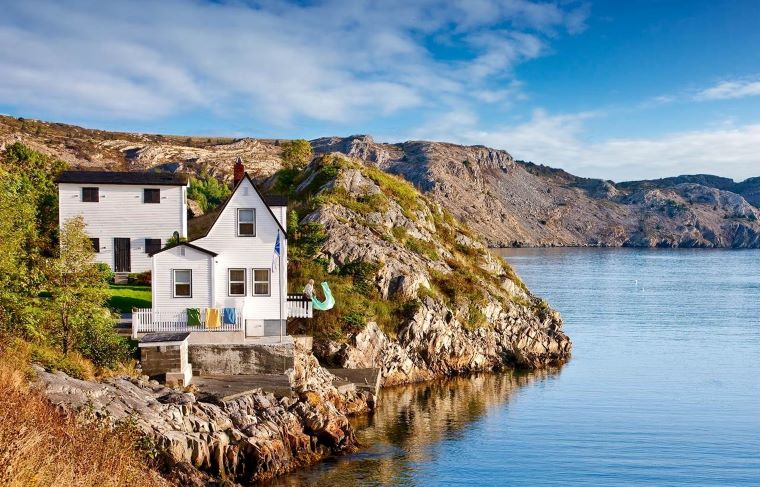
As the COVID-19 crackdown continued and my classes were being taught online (not pretty for an old sod like me), my wife Linda and I decided to undertake yet another Atlantic Bubble trip to St. John’s, Newfoundland, and explore more of the Avalon Peninsula. While “The Rock” is not exactly in our backyard, we had overlooked it as a travel destination for over a decade, opting instead to boogie board in Sligo, Ireland, or poking around the fairy-haunted glens of Betsy-y-Coed in Wales.
But on a bright morning, we boarded a flight with our other masked companions for the province’s capital city. On my list of places to explore this time were Holyrood, Cupids, Brigus, Bareneed, Hebb’s Cove, and Dildo. In addition, we hoped to revisit Cape Spear and possibly take a quick trip to Signal Hill to curse the gods who had drenched us there on our last visit.
I had rented a compact car for our travels from Budget but when we got there, a kindly young woman said she had upgraded us to a black Chevy Equinox. I said no thanks, too big, a veritable tank of an SUV that I had seen too many times on Homeland. It was, at least in my mind, the standard vehicle of the American FBI and CIA. If memory serves me at all correctly, I had also once stared down George Bush Jr. in one of those behemoths during his singular visit to Halifax in 2004. I was holding up a surfboard at the time, with the slogan “Surfers for Peace” right to his face as his motorcade drove up Robie Street. According to my memory, we made eye contact for a longish portion of a second and he had a most befuddled look that is still etched in my memory.
The rental woman admitted at that point that it was actually the only vehicle they had available so that settled things as I tried to explain my antipathy toward the big bossy black Chev. I still didn’t like the idea that locals would think we were American Feds out in the boonies on some clandestine mission, but my wife assured me I was yet again delusional, so we drove it away from St. John’s International Airport in search of groceries and beer as is our tradition when visiting foreign (or not so foreign) territory. This too proved to be just a tad troublesome, as there was a strike underway of grocery and liquor store workers and we had to deke around suburban neighbourhoods, well concealed behind tinted windows, until we could find a liquor store and no picketers.
We drove on down to Duckworth Street where we had again rented an apartment, this one above a Philipino restaurant in a part of town that had many other interesting looking ethnic eateries. As a general rule, when traveling, we tend to eat ethnic foods that are not part of the local cuisine.

Indian food is the staple for places like Ottawa, or anywhere in Ontario for that matter, as you never really want to settle for something labeled “Canadian.” Lebanese food would be the best bet while in Halifax and, of course, any restaurant with an exotic foreign sounding name might get you through travels in the U.K. In the USA, pick Italian or Mexican, of course. Don’t get me wrong, I would gladly eat an Irish breakfast in Nova Scotia or even a feed of Newfoundland cod tongues at home as well. It is just more exciting to see what the local version of ethnic is whenever you find yourself peckish on a journalistic junket like this.
Thus, for our first meal, we settled on a highly praised (by TripAdvisor at least) unique Asian vegan restaurant called The Peaceful Loft, which was just a few blocks down from our apartment. It turned out we were the only patrons – probably because we were having dinner at 4 o’ clock in the afternoon. There was no alcohol involved (are vegans non-drinkers? I wondered), but the aromatic tea was on the house and our host was undoubtedly the most friendly and convivial restauranteur on the entire eastern seaboard of North America. On the menu were dishes from Macau and a lot of foodie things that were vegan replacements for ham, chicken, and fish. I can’t explain how they do that – or even why – but it was all great to eat and the sauces were homemade and unique.
Later, we revisited Broderick’s on Water Street for some much-craved-for Newfoundland and Irish music. Once again, the performers were top notch.
The next morning it was off to Cupids and Dildo. I believe I got lost yet again trying to get out of St. John’s in our big black beast, ending up among the shopping malls of Mount Pearl and Paradise thanks to some insidious conspiracy probably created by chain store moguls. Eventually, we found the elusive TransCanada Highway and pointed our Equinox a bit south and west as if we were about to drive the entire 7,821 kilometres from the east coast to the west coast. We passed through Butter Pot Provincial Park, so named for a rounded hill of that name that supposedly looks like butter pot – which was lost on me as I didn’t know what a butter pot was supposed to look like. Then we cruised north on Route 62 to Holyrood. I was fairly certain the name of the town referred to the Christian cross in Anglo-Saxon, but some speculate that it is more specifically named for Holyrood House in Edinburgh, even though the town was mostly settled by the Irish like so many towns on the Avalon Peninsula. Although the community was originally settled for fishing and farming, the town’s website notes that, “in the 1890s when the fishery was in chaos, Holyrood men could be found shipping on the Great Lakes, building the subways of Boston, searching for gold in the Klondike, working in shipyards in Philadelphia and Seattle, and a host of other occupations.” And if I hadn’t spotted an ill-placed oil refinery along the shoreline, we might have stopped to see if any descendants of those men were around to share some lore about the town and its history.
But it was on to Lakeview and Harbour Main along a stretch of glorious coastline. I guess the thing that struck me most was how tidy everyone’s house and yard were and how green and lush were both the yards and the forests. If you know where to look in this rock-strewn province, you will find enticing pockets of green and grand deciduous trees. And that is certainly true of this southern shore of Conception Bay. It is a most pleasant scenic drive on up to Marysvale and Georgetown, but when we stopped to gawk at the hilly coast and pristine waters, I was cognizant that we still might appear as American spies as we took snapshots of the grandeur. Or were we possibly scoping out a potential location for a safe house for Soviet defectors?
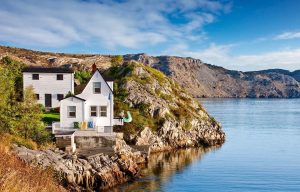 Now, just because we had decided to travel to Cupids and Dildo, it was only partly true that we were headed out there because both towns sounded funny and interesting. Both had a bit of history to them, naturally, and I had researched some hiking trails that sounded out of this world. We paused for a sip of coffee in Brigus, so named for the town of Brickhouse in England although it was mostly settled by Irish and Welsh. Here was the home a range of famous explorers whose last name was Bartlett, including Robert Bartlett who had accompanied Peary on his Arctic explorations.
Now, just because we had decided to travel to Cupids and Dildo, it was only partly true that we were headed out there because both towns sounded funny and interesting. Both had a bit of history to them, naturally, and I had researched some hiking trails that sounded out of this world. We paused for a sip of coffee in Brigus, so named for the town of Brickhouse in England although it was mostly settled by Irish and Welsh. Here was the home a range of famous explorers whose last name was Bartlett, including Robert Bartlett who had accompanied Peary on his Arctic explorations.
Then it was on to Cupids Cove, the site of Cupids Plantation, which to me sounded completely illogical. I associated plantations with the American South where settlers grew cotton and tobacco and those seemed to me to be the most unlikely cash crops this far north. However, I soon learned that a “plantation” was simply a settlement. According to the provincial Heritage folks, “Thirty-nine colonists set out from Bristol in 1610 under John Guy, an experienced Bristol merchant. They had detailed instructions; they were to fortify the settlement at Cupids (then known as Cuper’s Cove) in Conception Bay, experiment with farming, cut spars and planks, make salt, potash and glass, collect samples of ore and, significantly, to fish and trade in cured fish and train oil.” Train oil, really? Okay, well that was what they called the oil made from the blubber of whales in those old days. John Guy, as it turned out, was a bit of a greedy bastard, wanting more land and not always paying his men. So, one might wonder why the former Newfoundland government (before Confederation) put his mug on a postage stamp and elsewhere?
Officially, this was the second oldest English colony in the New World after Jamestown in Virginia. However, things did not go smoothly. Poor soil, difficult climate, death, and pirates plagued the early settlement. But it was a start. And the rest, as they say, is history.
As we pulled into Cupids, I accidentally pushed a button on the dash and the roof opened up. The Big Chev, it turned out, had a hidden sunroof that stretched over the front seat and the back. This was obviously designed so that someone, perhaps an army sniper or terrorist, could stand up and shoot at adversaries while driving to or from some crime scene as they did in the Jack Reacher films. But now, looking up, I could see that Cupids had greeted us with more blue skies and wispy clouds.
Cupids today is a fishing community among other things. We drove around the harbour and on to the end of the road near Spectacle Head. The trailhead was well marked so Linda ran on ahead as I took my usual ample time ambling up the stoney path on a couple of humpback hills that reminded me of the ones near Peggy’s Cove back in my home province. I noticed some coyote scat – or at least that was what I thought it was – and also some other forms of dung that had the colour of blue like in the old bottles of ink you would pour into an inkwell. As I watched Linda ascend a steep grade on a bare rock slope, I then noticed the abundance of blueberries growing on the low wild shrubs. A taste here and there convinced me that these were the best tasting blueberries in the world but then remembered that I had said that to myself back on Bell Island. And no, I decided, I did not have to make a final decision as to which crop was most excellent, damn it.
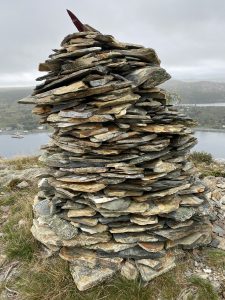 As I hiked to higher elevations, I decided that making such inquiries locally might raise further suspicion that we were on some covert mission to discover the secrets of coastal Conception Bay – the lush green yards with their concrete gnome statues, the apparent fecundity of the land, the abundance of fish, and free-for-the-harvest fruit. No, better to keep questions to myself.
As I hiked to higher elevations, I decided that making such inquiries locally might raise further suspicion that we were on some covert mission to discover the secrets of coastal Conception Bay – the lush green yards with their concrete gnome statues, the apparent fecundity of the land, the abundance of fish, and free-for-the-harvest fruit. No, better to keep questions to myself.
You see, since my wife was often ahead of me on these jaunts, I had lots of time to think about a wide range of questions that haunted my curious brain. The names of towns like Witless Point, Bareneed, Come-by-Chance, Old Shop and, of course, Cupids. Then there were the famed town heroes/villains: the scoundrel John Guy and the pirate Peter Easton who threatened the town. The local lore and the price of a cottage down the road on Cod Jigger Lane.
It is amazing the stuff that goes through your head when you are breathing heavily and hiking to the top of a place like Spectacle Head.
Head, for example, is a reference to a headland, in case that was not completely obvious as it was not to me when I first moved north to asylum in Canada. Up until then, I thought that the colloquial use of “head” referred to someone who did drugs or was used as a reference in bands with names like Radiohead, Motörhead, the Talking Heads or Machinehead.
Linda waved to me from the pinnacle of the first hilltop as she stood beside a stone sculpture of sorts called “American Man.” It wasn’t really much like a man at all but a neatly piled formation of rock that had been around since the 1930s. It had been vandalized a few times over the years probably because there would always be someone in most any community who would want to take down the proverbial American male a notch or two. But it was always rebuilt, and one local said that there was really nothing American about it. It was just a corruption of “Marking Man.” And, of course, that is how these things go. All that aside, here was a well-orchestrated pile of the flat slate slabs that were meant to represent the barrel-like body of a person. It was made from the same stones that made for slippery going on this hike. Linda had already charged off from there to the next pinnacle as is her way. I huffed and puffed until I too stood shoulder to shoulder with the American Man.
I caught up with my dear wife atop Spectacle Head, so named because the view was spectacular. It was one of those places where you take a dozen or so photos, blown away by the sweeping panorama of sea, sky and cove, only to return home to discover the photos did little to reveal just what a spectacle it was. Enough so to want to make you stop taking photos and just live, breathe, and take in the moment. Which we all should do more often anyway, and to hell with Pinterest and Instagram.
Back down at sea level, drinking cold stale coffee (which always tastes so good on a dead-end road in a place like Cupids), we hastily decided to buy a cottage here. Cupids had woven a spell over us, and this should absolutely be our second home – a seaside haven with a deep, rich, convoluted history, a quiet place far away from the havoc of modern civilization. As the coffee grew colder, Linda did a quick recon on her phone (so often a mistake) to discover that land and houses were not cheap here. A tiny fisherman’s shack of 400 square feet across the harbour on said Cod Jogger Lane was going for a mere $199,000. Apparently, there were scads of people out there wanting a cottage in this cozy corner of the Rock. So, alas, it would not be our second home.
I had sussed out a second hike here, the less appealing sounding Burnt Head Trail. I slowly tooled the hefty Equinox back through town, waving through the open skylight at the older men and women tending their tulips in raised beds, until we came to another dead end at a cemetery. I really like walking around cemeteries, and I think we ate the sandwiches we had brought among the many headstones of the Morgans and Bishops who had been planted here. We have even gotten to the point where we are connosoirs of headstones, saying things like “That would be a nice one to have,” as we eat our homemade chicken and pickle sandwiches and point to a really snazzy black granite marker with an etched image of a spaniel or a Harley-Davidson.
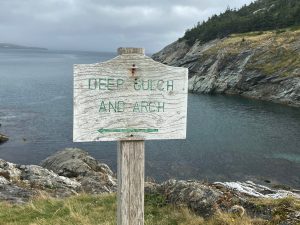
Now, if you ever find yourself parked at the trail head for Burnt Head Trail, you will discover that you are looking at an old church that once hosted the attendant graveyard populated by the Morgans and Bishops. And the church, which is in most excellent shape, is or at least was when we were there, a bed and breakfast. It was, however, now closed for COVID-19 or other dire reasons. As we began our second hike of the day, we discovered that someone had built an outdoor Elizabethan theatre in the backyard of the church B and B. Apparently some entrepreneurial animateur must have staged plays there of a traditional nature during the warmer months.
Most certainly there was a story here about its origins and, in typical Atlantic Canadian fashion, I couldn’t help but assume it was a “Come-From-Away” – presumably a theatrical husband and wife team from Toronto or some other distant city. As we headed into the beautiful wilderness behind Cupids’ answer to the Globe Theatre, I could clearly picture a married pair of PhDs in English Literature, both on the grey-hair side, sitting in their posh urban digs over a bottle of Malbec saying, “If only we could move to a remote corner of North America, somewhere at the end of a road and buy an old church to fix up, set up an inn for art lovers to come and do yoga, make pottery, read poetry, and participate in mounting a consummate version of King Lear in a bucolic setting with the sound of mosquitoes buzzing in their ears. If only…”
And the brilliant thing is that they must have done just that until certain harsh facts of real life on a remote coast kicked in as ticket sales failed to materialize without any big-name stars willing to come to Cupids for an off-off-off Broadway Shakespeare production. But I still bet there was a tremendous amount of naïve enthusiasm involved, which I personally endorse and so should you. Follow your dreams, brothers and sisters! Climb every mountain. Ford every stream. Until you end up in a swell place like Cupids staging A Midsummer Night’s Dream.
And if this is already planting images of rural thespian heaven in your head, then the good news is (or was when I was there) that the whole shebang is for sale. For, as we were walking past the theatre to our right and the graveyard to our left, I found a large red and white For Sale sign that had been ripped off the building by either a typical hurricane-like nor’easter or some local ne’er-do-well Shakespeare hater.
Well, into the woods we went and were thrilled to discover that the Burnt Cove hike exceeded all expectations, even topping Spectacle Head. There were forests, fields, and streams aplenty and the kicker was a jagged, mountainous coastline with deeply indented canyons filled with swishing seawater, swaying seaweed, and wondrous waves that deserved their own audience applause for which we were glad to provide. All the world’s a stage, indeed, and we were front row and centre. And I should reiterate that we liked everything about Cupids very much. Before we left, I parked at the intersection of two gravel roads to study the map, not far from the driveway of a man who was cleaning out his garage. He eyed us suspiciously as Linda pushed the button to open up the hidden sunroof and I don’t blame him. I was hunkered over the map, but Linda noticed that he was yelling something to us and then retreating into his house. I assumed he probably was just offering us a friendly hello or a “Whaddayaat?” but he could have been going for his gun. Either way, Linda advised that we vamoose, so we made our exit from a place that had now etched its way into our hearts.
Linda was advising me to stop being so bloody sensitive about the appearance of our spymobile, so I decided maybe we should get some fresh, hot coffee and wondered out loud if Tim Horton had found his way to these shores of Conception Bay. Sure enough, there was one in Bay Roberts, and it was filled with boisterous men in overalls talking up a storm. After the bucolic charms of Cupids, Bay Roberts was a bit of a shock – heavy traffic, strip malls, and just too crowded for my liking. Linda asked me why I had ordered a coffee big enough to share with an entire football team, but I found that it settled my mind a bit as we drove north to Spaniard’s Bay and east towards Trinity Bay, listening to “Night Drive” by Garnet Rogers with its most excellent distortion guitar.
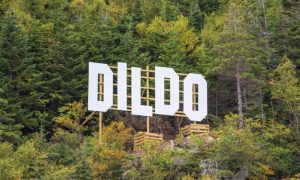
When you pull into Dildo, the first thing you notice is the wooden sign with the name of the town perched on a hill above the harbour, a kind of homage to the famous Hollywood sign in California.
It speaks of the sense of humor that seems to pervade the town that has been the butt of jokes for perhaps a century or more. The name has proverbially “put the town on the map” much in the same way that it has for a number of other communities such as Condom, Intercourse, Penistone, Middlefart, and Shitterton.
Not to mention Hell, Wetwang, Ball’s Falls, and Punky-doo Corner. In an article titled “There’s No Place like Dildo,” the unnamed author suggests that none other than James Cook named the town while surveying the coast, but that seems unsubstantiated. The author rightly states, however, that here, “Houses hug the rocky shores, following the twists and turns of the road which, no doubt, lies atop the walking trails of old.”
I had been told that the name was a reference to a wooden peg used to help keep an oar in place while rowing a dory, but Atlas Obscura says it is an older reference to a glass tube – something like a test tube. It also claims that “Many have found the town’s name to be offensive, filing petitions to have it changed. However, the majority of the community of Dildo is just fine leaving the name as it is.” So, clearly the debate over the name has been going on for some time now although the pro-Dildo faction rules, even promoting the annual Dildo Days to attract as many curious tourists as the town can handle. We cruised back and forth looking for the craft beer brewery that further promotes the moniker, eventually finding it and buying a couple of cans of Blue-Eyed Bouys, a Pilsen Thank You, a Saltwater Sour and, of course, a Where the Helles Dildo? before leaving town.
Back on Highway 60 headed south to the TransCanada and home, we discovered the Yes B’y Indian Kitchen – dynamite take-out Indian food that made for our evening meal. I was a bit disappointed that we didn’t have more time to explore the rest of the Baie de Verde Peninsula that separates Conception Bay from Trinity Bay. But we would be back to investigate the more northerly Heart’s Delight, Turks Cove, Old Pelican, and especially New Melbourne, which actor/comedian and fellow surfer Sean Majumber told me was the surfing capital of Newfoundland.
My spirit was somewhat deflated that evening when I learned that, in a few days, a hirricane was predicted to come ashore at our home at Lawrencetown Beach back in Nova Scotia. I spent a couple of hours on the phone with the airline trying to rebook an earlier flight so we could get home to batten down the hatches before the big wind. During the call, I learned that all that propaganda about being able to rebook for free during the pandemic was baloney. You can rebook without a fee, yes, but you have to pay extra for whatever is the current price was for seats – which was substantially more than what we paid. So, after a bit more consultation with the Environment Canada weather site, we decided that we would most likely arrive home before the storm hit so we decided to stay in Newfoundland and keep our expedition rolling.
Story by Lesley Choyce / www.lesleychoyce.com




















I just happened upon your intriguing post about your Newfoundland travels and enjoyed it so much — and your humorous descriptions of the black car, etc. Thank you for sharing this story of your adventures! Several years ago I travelled to Newfoundland from Florida and fell in love with the beautiful landscapes, hiking trails, and the hearty, welcoming people. Part of my travels took me to Fogo Island, with its magnificent vistas and fascinating history (not to mention the delicious fare and gin at the Fogo Island Inn. I hope to return to Newfoundland some day.